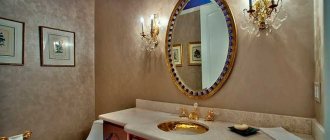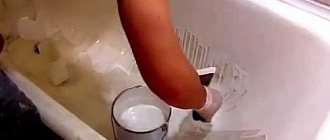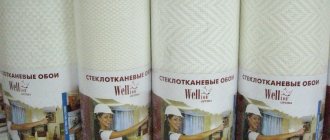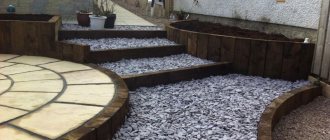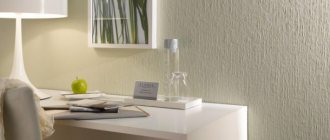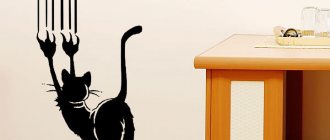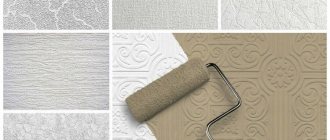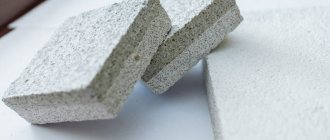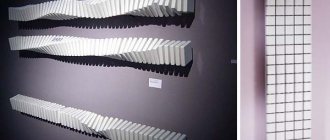Manufacturers offer a large selection of wallpaper coverings. The material differs in texture, raw materials of the front layer, and density. IN They produce products on a paper or non-woven basis.
Non-woven fabric is a group of textile non-woven materials. Cellulose and fabric fibers are bonded with special components and pressed. The base does not change size (does not stretch or contract) due to exposure to water.
Types of wallpaper for walls
Classifying types of wallpaper is a labor-intensive task, but you can still try to put everything in its place.
Types of wallpaper by surface type
So, depending on the type of surface, wallpaper can be:
- smooth;
- embossed;
- with imitation of some material . Sometimes modern wallpaper that imitates coverings made of tiles, wood, etc. is difficult to distinguish from the original without touching it.
Types of wallpaper based on water resistance
In this regard, wallpapers can be divided into the following groups:
- ordinary wallpaper , which is best used in rooms where there is no direct contact with water, and contamination will be minimal, since they cannot withstand moisture. They can only be cleaned dry ;
- moisture-resistant wallpaper can already withstand cleaning with a slightly damp sponge, but will not be able to survive contact with detergent;
- but washable wallpaper is a godsend, because it can be washed using detergents , so you shouldn’t be afraid of getting this material dirty;
- There are also super-washable wallpapers , which differ from the latter in that they can also be rubbed with a brush , and washed even every day. This is an example of perseverance and endurance.
Wallpaper density
Depending on the density, wallpaper is divided into
- light with a density of 110 g/m2;
- medium , 110-140 g/m2
- heavy with a density of more than 140 g/m2.
The denser the wallpaper, the better it is able to hide wall defects, but the more difficult it is to stick. The lightest wallpaper not only allows the entire relief of the wall to show through, but can also stretch during installation and produce waves. It is better to focus on medium-density wallpaper.
Depending on the appearance and color, the wallpaper can be plain or with a specific pattern, then gluing it will be a little more difficult, since you will need to join the fragments.
Photo wallpaper
This is an interesting and low-labor way to solve the design in various styles; their range is truly limitless. It is possible to produce photo wallpapers to order. Their use makes it possible to:
- “revive” the interior with paintings of nature;
- design them as a perspective observed from a false window;
- order a company logo or depict new products.
They also have advantages during installation:
- gluing occurs very quickly;
- the colors in the images do not lose their brightness for a long time;
- You can choose the installation method yourself: self-adhesive or using glue.
The disadvantage, or rather a prerequisite, is the requirement for an absolutely smooth surface, otherwise the natural effect disappears. Inexpensive material can come off over time, so it makes sense to take a more expensive one - it will be less hassle.
Photo wallpaper can be made to order according to your design
Designations on the wallpaper: decoding
The resistance of the wallpaper to water and sun, strength, type of gluing and other characteristics are indicated by the symbols that are on each roll. Their meaning is easy to guess purely intuitively, but we will still give a decoding of the icons on the wallpaper.
We also give an example of wallpaper markings that you need to pay attention to.
It is especially important that the batch number matches. Color may vary slightly between batches.
What are the disadvantages?
Non-woven wallpaper also has some disadvantages. And perhaps, taking them into account, someone will decide that this type of coverage is not entirely suitable for them:
- dust will accumulate on the textured surface, which requires regular cleaning;
- a large relief pattern can be damaged by pets or small children, which is important to consider when choosing;
- Having purchased wallpaper for painting, you will also need to spend money on the paint itself;
- some types of non-woven wallpaper (structural and relief wallpaper on a non-woven basis) have a high price;
- While playing, children or pets may accidentally damage the wallpaper.
Read about what kind of installation of two-level stretch ceilings is considered professional and what are the features of performing work on installing tension structures.
See photos of door decoration with decorative stone here - simply incredible possibilities for decorating doorways!
Read everything you need to know about glue for block parquet at: https://ru-remont.com/poly/parket/tehnologiya-ukladki-shtuchnogo-parketa.html
The transparency of the non-woven fabric itself has already been mentioned. Therefore, the working surface should be plain or the wallpaper itself should have a darker color so that stains on the walls do not show through.
The glue itself can leave traces, so any excess must be removed immediately when gluing.
The exception is textile wallpaper on a non-woven basis - they are not translucent.
Wallpaper material for walls
The broadest classification is the division of wallpaper by type of material:
- paper;
- vinyl;
- non-woven;
- glass wallpaper;
- photo wallpaper;
- textile;
- carpet;
- metal;
- cork;
- liquid, etc.
It’s worth taking a closer look at this parameter and considering what pros and cons each of the listed types of wallpaper contains.
Paper wallpaper
Paper wallpaper is a classic; it is the most common guest on the walls of even modern apartments. And all this is explained by their advantages , the main one of which is the more than affordable price. The appearance can also suit any design idea, since paper wallpapers are available in glossy and matte , with different patterns or simply plain, they can be embossed or even coarse fiber. The latter are designed for painting and can withstand up to 15 cycles of such repainting, so updating the interior will be very simple.
Embossed wallpaper is two layers of paper that are pressed when wet and acquire a certain relief. The coarse fibers between these layers of paper also have shavings, so in both cases an interesting effect is achieved only due to the texture. In addition, they can hide minor defects in the wall surface.
Also among the advantages is the environmental friendliness of paper wallpaper, its ability to “breathe”, so it creates a completely healthy microclimate in the room. There is also a low ability for heat and sound insulation.
But there are also disadvantages , which boil down to fragility, fragility, the inability to wash the wallpaper, with some difficulties when gluing, since then they are easy to tear, etc. That is why they are often used in dry rooms without a high probability of dirt and water getting in.
Vinyl wallpapers
Vinyl wallpaper confidently competes with paper wallpaper. They have a two-layer structure : the first layer is paper or fabric, the second is polyvinyl chloride, which provides all the properties of these wallpapers. Their main advantage is the ability to wash with detergents, excellent wear resistance, durability, resistance to temperature changes and various microorganisms, etc.
It is impossible not to note the excellent appearance, as well as the variety of possible types. Depending on the type of treatment of the front layer, vinyl wallpapers are divided into :
- wallpaper based on foamed vinyl - in this case you get a deeper texture and an interesting look;
- based on silk threads , and as a result the wallpaper turns out to be especially chic;
- compact vinyl , which plausibly imitates coatings such as textiles, tiles, etc.;
- with chemical embossing , which makes the surface even more resistant to abrasion and moisture.
Vinyl wallpaper is good for use in rooms with high humidity and high traffic: kitchen, hallway, offices, etc. The disadvantages include not the easiest gluing method, which is often only possible for professionals. This wallpaper also does not allow the walls to breathe.
Non-woven wallpaper
This type of wallpaper is single-layer, made from fibrous cellulose with the addition of various components. The result is environmentally friendly, breathable wallpaper with a simple gluing method .
But, unfortunately, such wallpaper requires serious surface preparation, and during use it is easy to scratch and damage it. confusion with the concept of non-woven wallpaper , since non-woven wallpaper is also often called non-woven wallpaper. Such wallpaper is usually produced for painting and can withstand about 3 repainting cycles. They glue a little differently, and they don’t allow air to pass through.
Textile wallpaper
Textile wallpaper is based on dense paper, on which the threads of the fabric are fixed. Without going into the details of their manufacture, it is worth noting that they are quite environmentally friendly, pleasant to look and feel, have the ability to absorb sound, retain heat, and are difficult to burn.
The variety of types is also amazing , since textile wallpaper can be made from almost any fabric, so you can find linen, silk, synthetic, felt, jute and mixed fibers. They have slightly different characteristics that are characteristic of a particular fabric.
Among the disadvantages are the relatively high price and some difficulties in the gluing process. It is also worth noting that fabric wallpaper is more prone to attracting dust than all others, and therefore needs more care.
Carpet wallpaper
Carpet wallpaper is somewhat reminiscent of textile wallpaper, but here a pile is attached to a paper or fabric base, and as a result a real carpet is formed on the wall, and this is a plus for comfort and sound insulation, but in terms of cleaning it is a small minus, since carpets accumulate dust and static electricity. You will need to clean such wallpaper with a vacuum cleaner, so there will not be any special problems, but in order to always keep the walls clean, this procedure will need to be repeated regularly.
Glass wallpaper
Fiberglass wallpaper is made using special glass threads, which affects the properties of the finished material. Thus, fiberglass threads can form various patterns and textures, which will then have a good appearance when dyed. Fiberglass threads give the wallpaper excellent performance properties : environmental friendliness, no breeding ground for various microorganisms, such wallpaper will not accumulate static electricity. In addition, they withstand the influence of fire, are moisture resistant , vapor permeable, and withstand the influence of certain chemicals, incl. detergents.
Separately, it is worth noting the reinforcing properties of fiberglass, so such wallpaper can be used on surfaces with some flaws: small cracks, irregularities, seams, etc. Another advantage is the possibility of using them on any type of surface: concrete, brick, wood, etc. – they can be glued to all this quite simply. Fiberglass, in principle, is an ideal material, but with a slight drawback - there is not a very large selection of patterns and textures.
Liquid wallpaper
Liquid wallpaper and wallpaper can only be called a stretch, since they do not have a traditional paper or fabric base , and in general their application does not involve gluing, but they also cannot be classified as plasters, since they do not contain sand. Liquid wallpaper consists of cellulose, which is responsible for the stickiness, various fibers and powder, which add decorativeness.
This entire composition is diluted with water in the correct proportion and applied to the walls or even the ceiling with a spatula - even a not very trained person can cope with this task. Liquid wallpaper can form a varied surface : smooth, with a certain texture, simulating other materials, such as stone, etc. The surface itself is quite decorative and durable - it can last for decades. And caring for it is not difficult : since dust does not accumulate much on such wallpaper, you can simply use a vacuum cleaner or a damp cloth, because the surface is not afraid of moisture. If a fragment has been damaged, the defect can be easily corrected.
The only drawback of such wallpaper is that it cannot be used in rooms where there is constantly high humidity or constant direct sunlight.
Wallpaper Linkrust
Wallpapers like linkrust are now returning to their former popularity. In them, as in many of the types described above, there are two layers of material : a paper base and a decorative layer of plastic mass. To perform the latter, alkyd resins, various gels based on wood flour, cork shavings, etc. are often used. This mass can be given almost any shape; as a result, you can make wallpaper to look like stucco, imitate some other surfaces, etc. The huge advantage of such wallpaper is that it is easy to care for, as it is easy to clean and can be washed.
Cork wallpaper
Cork wallpaper is an example of naturalness and environmental friendliness . In their production, oak bark is used, which is pressed under high temperatures; under these conditions, a natural adhesive substance is released, which ensures the integrity and strength of the wallpaper. Cork wallpaper creates a cozy atmosphere in the house, reduces the thermal conductivity of walls, and increases sound insulation. Their disadvantages include the price, as well as some difficulties in gluing and operating, since they tear quite easily.
Wallpaper based on wood veneer
Wood is also used here, but in the form of veneer, which is glued to a paper base.
As a result, you can imitate the surface of wood, and the coating will be environmentally friendly; in this regard, it is second only to cork wallpaper. Such wallpaper is simply attached, absorbs air, breathes, adds thermal insulation to the walls and looks great. Their price is high, but decorating walls with such material will cost much less than using wooden panels.
Wallpaper based on serpyanka
In such wallpaper, the paper base is covered with a layer of cellulose, and the top layer can be formed in different ways, forming a huge number of different textures. The finished material turns out white, it can be painted in any color, and more than once . And if you use waterproof paint, then such wallpaper can also be washed. Other advantages of this material include naturalness, breathability, vapor permeability, ease of use, etc.
Metal wallpaper
Metallic wallpapers appeared relatively recently, and initially they were needed in order to reduce the negative impact of radiation from the equipment used: microwave ovens, computers, telephones, etc.
But their purpose is now rarely remembered, since in appearance they turned out surprisingly good. As you might already guess, they are made by gluing thin foil onto a paper base, on which you can create any ornament or design. The advantages of such finishing include high decorativeness, the ability to thermoregulate, and ease of maintenance, since the surface is easy to clean. But among the minuses , it is worth noting the lack of ability to allow air to pass through and the fact that this wallpaper is very easy to damage with sharp and not very sharp objects.
Photo wallpaper
Photo wallpaper is a special type of wallpaper, which, as a rule, is used to decorate only part of the wall, but this part can greatly transform the room, giving it a certain character. They are made simply - by applying images to paper: landscape, flowers, animals, streets, cafes, etc. – the choice will amaze even professional designers. The manufacturer cuts the picture into fragments of a certain size and quantity, and the buyer assembles them at home. The gluing technique is not the easiest, but if desired, nothing is impossible.
Non-woven
This type of wallpaper, having appeared on the market, immediately found its fans and very quickly gained popularity. There are several reasons for this:
- Based on non-woven material, they have increased strength and density;
- are environmentally friendly;
- do not shrink or stretch, as they do not get wet;
- practically not subject to burnout;
- have sufficient thickness to hide surface unevenness, which eliminates the need for putty before gluing;
- fire resistant.
The main disadvantages, of which there are few, are:
- some difficulty in maintenance, since dust is difficult to remove from reliefs;
- the relief structure can be easily damaged by careless handling of piercing and cutting objects.
This type of wallpaper, having appeared on the market, immediately found its fans and very quickly gained popularity
Wallpaper for different rooms
Not every type of wallpaper is suitable for every room. It is necessary to take into account both its functional features and the degree of illumination, as well as its size and configuration. And yet, there are general recommendations on how to choose wallpaper depending on the type of room:
- Bedroom wallpaper should breathe. There are no splashes or fire here, so inexpensive paper wallpapers, as well as non-woven ones, are suitable. You can use textile and carpet as well as cork, based on serpyanka and wood veneer. Metal and photo wallpapers are used for an accent wall;
- Wallpaper for the living room may be subject to increased wear and tear, since there are always people in the living room who can accidentally stain, scratch or even paint something (we are talking about children, of course), so it is better to take vinyl or non-woven wallpaper. If the living room is usually quiet, then paper ones will do. All other options are also suitable, but glass wallpaper and liquid wallpaper are somewhat boring for the hall;
- Wallpaper for the kitchen should withstand high humidity, and ideally be washable. It is better to avoid materials with a pronounced relief. Vinyl wallpaper, glass wallpaper, liquid wallpaper, and some photo wallpaper are optimal;
- Wallpaper for a nursery should combine environmental friendliness and wear resistance. Paper wallpaper is suitable and will need to be changed every 2-3 years, which is also useful from a psychological point of view. You can use liquid wallpaper, cork wallpaper, non-woven wallpaper. Photo wallpaper is used for emphasis;
- Wallpaper for the hallway takes on the constant impact of drops of dirt and water, they get dirty from shoes and umbrellas, so it is better to use liquid wallpaper, glass wallpaper, and washable vinyl sheets.
Rare and exotic coatings
In addition to well-known types of wallpaper, there are rare and unusual ones. This group is represented by:
- wallpaper made from dry Japanese grass and bamboo is original, fashionable, but may not last long in homes with curious small children and pets;
- genuine leather, which are harmless to health, have high sound insulation, and demonstrate luxury and prosperity;
- metal, created using modern unique technology, creating unusual interiors
- wood, giving the interior sophistication and chic.
All of these are natural and safe materials, expensive and creating the same expensive and luxurious interior.
Wallpaper made from dry Japanese grass and bamboo is original, fashionable, but may not last long
How to choose the color of wallpaper?
But when you have decided on the type, you need to decide which wallpaper color is best , because the decorative component of this material is just as important as the functional one.
An ineptly chosen color can not only ruin all the advantages of the room, but also not have a very good effect on those people who are constantly in it. To choose the right wallpaper color, you need to analyze the lighting level of the room , its purpose and size:
- if there are a lot of windows and they face south , then the room needs to be cooled, as it were, using cold shades, which will also expand the space a little: blue, green, dark blue, gray, etc.;
- dark rooms with warm-colored wallpaper: peach, golden, yellow, orange, lemon and similar colors are suitable;
- For a hallway , saturated shades that are neither light nor dark at the same time are a good choice: so that they are easily soiled and do not bring gloom into a room that is not the brightest;
- Wallpaper for the living room , the face of the apartment, is selected to your taste, depending on the lighting, and most importantly, do not forget about how this wallpaper will be combined with the furniture. This also applies to other premises;
- the color scheme in the kitchen should be bright, since bright colors stimulate the appetite, but not have acidic shades, which will simply irritate;
- in the bedroom it is always recommended to use light pastel shades so that they are not particularly noticeable and do not distract from relaxation, but for energetic people and young people we can recommend brighter options - you need to start from your preferences;
- There certainly shouldn’t be anything bright in the nursery
- The area and height of the room also plays a role , so the smaller and lower the room, the lighter the wallpaper should be, and a large pattern on it is undesirable - at most some kind of small pattern.
combine two types of wallpaper in one room . One of the walls can be made an accent by choosing a canvas of a highlighting shade, or with an active pattern. The walls can be divided horizontally, using darker wallpaper at the bottom and lighter wallpaper at the top. You can play with both color and ornament.
What is non-woven fabric?
Non-woven is a common name for two different types of wallpaper that contain a material called non-woven. In fact, there are wallpapers that are made entirely of non-woven fabric, and a non-woven coating.
What is so special about such an unusual material as non-woven fabric? Anyone who deals with sewing knows that interlining is sewn onto some parts of clothing to make these parts more dense and durable.
Interestingly, it feels like fabric , but looks like paper . So what exactly is its composition and production features?
Read about what types of round interior door handles there are and how to choose the right fittings for interior doors.
Find out about silicone-based paints for painting walls in an apartment in this article. Only the right recommendations from professionals on choosing the type and type of paint for interior work.
The basis of non-woven fabric (70%) is cellulose - the same one that makes up the paper we are used to. Cellulose fibers are arranged in a special way, impregnated with a small amount (30%) of binders.
The components are pressed to form a non-woven fabric. How is it different from plain paper? Greater density, wear resistance and strength.
Consequently, wallpaper that contains non-woven material differs from paper wallpaper in that it will last a long time and will not tear so easily . At the same time, they have greater fire resistance and are not afraid of water. The non-woven fabric itself allows air to pass through well.
In conclusion
When choosing wallpaper directly in the store, you need to focus not only on how it looks in a roll - it is advisable to unroll it and see how it will look when placed on the wall. Always remember about combinations , so choose wallpaper that already matches existing furniture and decorative items, or they will then have to be combined with wallpaper. And if you are not sure what appearance the wallpaper should have, then it is better to opt for a plain version of a soft shade. And, of course, take into account the parameters of the room: different humidity and temperature require different wallpapers. Pay attention to the certification and batch number - it must be the same, otherwise the color may vary slightly.
The article was written for the site.
Tags:Wallpaper
Textile (fabric)
Textile wallpaper is made from paper and non-woven fabric. A woven or braided material made of linen, cotton, viscose, jute, polyester, silk, etc. is glued onto this base. The texture can be smooth, silky, velvety. It depends on the material used and weaving technique. In addition, relief designs can be woven onto the fabric.
Textile wallpaper - looks great, but is expensive
Fabric wallpaper is another type of “breathable” wall decoration, and therefore can be used in living rooms. This is a very beautiful finishing material, but expensive. Even if we compare such not very cheap types of wallpaper as silk-screen printing or natural ones. At the same time, it is demanding in terms of operating conditions - it is afraid of high humidity, fades, and can only be cleaned dry, occasionally using a damp sponge.
There are two forms of release: standard - rolls 10 meters long (width 70-80 cm). Some textile wallpaper (more expensive) is sold by linear metres. Their width is usually 105-120, but there are also wider canvases.
Surface preparation
Usually, professionals are hired to work with this type of wallpaper. There are two reasons for this. Firstly, the material is very demanding, so you need to handle it as carefully as possible. Secondly, it requires cutting the wallpaper with precise calculations, and if you have no previous cutting experience, it can be quite difficult to guess.
Preparing walls for gluing fabric wallpaper
You need to glue wallpaper on fabric-based walls in the following sequence:
- Preparation.
- Cut out the canvas.
- Marking the wall.
- Gluing the walls.
- Impregnation of wallpaper with glue.
- Direct gluing.
Preparation begins with removing the old finish. It is important to remove absolutely all the finish, even if other areas are still holding up quite well. The goal of wall preparation is to achieve a perfectly flat surface as possible. Even small particles of cement or plaster that fall under the pasted layer can damage and tear the wallpaper.
When all the old finishing is removed, the wall is thoroughly washed, construction debris and dust are removed, and then plastered. When plastering, use a wide spatula to minimize the amount of unevenness. The dried surface is thoroughly sanded and primed with a deep penetration solution.
After this, they begin cutting the canvas. It is most convenient to glue in vertical strips 1-1.5 m wide. Therefore, leave marks on the wall every one and a half meters to guide you in the future.
For example, a wall is 5 m long. We measure two sections of 1.5 m and one of 2 m, and put marks. Check carefully and measure several times. The fewer seams and pieces, the better, but it should also be convenient to work with. Try to touch the front surface of the wallpaper with your hands as little as possible.
Now we measure the same segments on the canvas, but strictly adhering to two rules:
- seams must be smooth and vertical;
- the pattern must be adjusted so that the seam cannot be distinguished on the finished coating.
Features of operation
If you are going to update the interior, it is not necessary to tear off the fiber wallpaper and replace it with new ones; it will be enough to simply repaint it. That is, the material will be used for a long time, and therefore you should immediately purchase high-quality wallpaper, for example, made in Germany.
The quality of building materials from Germany is widely known among professionals in the repair and construction market.
Germany is famous for its specialists who are meticulous about the production process and ensure that absolutely all production standards are met.
